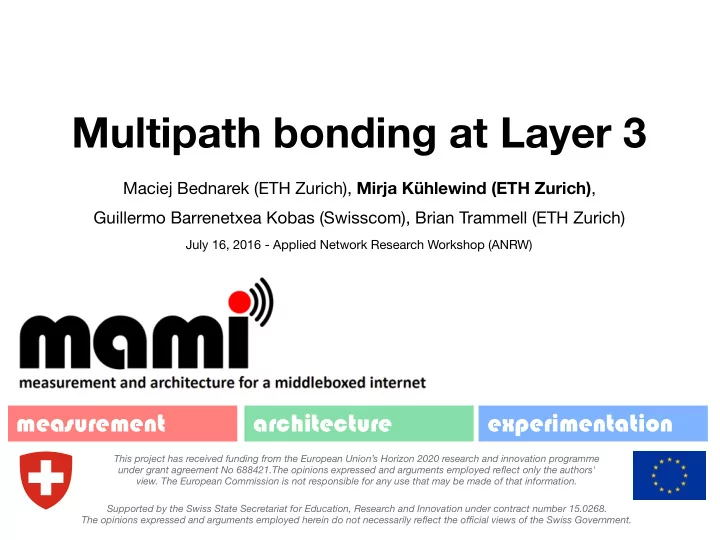

Multipath bonding at Layer 3 Maciej Bednarek (ETH Zurich), Mirja Kühlewind (ETH Zurich) , Guillermo Barrenetxea Kobas (Swisscom), Brian Trammell (ETH Zurich) July 16, 2016 - Applied Network Research Workshop (ANRW) measurement architecture experimentation This project has received funding from the European Union’s Horizon 2020 research and innovation programme under grant agreement No 688421.The opinions expressed and arguments employed reflect only the authors' view. The European Commission is not responsible for any use that may be made of that information. Supported by the Swiss State Secretariat for Education, Research and Innovation under contract number 15.0268. The opinions expressed and arguments employed herein do not necessarily reflect the official views of the Swiss Government.
Overview Motivation • Operator’s demand for aggregation of DSL and mobile capacity • Layer 3 Bonding Solution Architecture and Scheduling Algorithm • Implementation Packet mangling, scheduling, and re-ordering • Evaluation Single Flow and TCP cross traffic Conclusion • Works but further work needed…! M. Kühlewind: Multipath Bonding at Layer 3 2
Motivation: Aggregation of DSL and mobile capacity LTE Server Home IPTV User router DSL • DSL capacity is not sufficient to e.g. serve HD video service • MPTCP proxy only suitable for TCP traffic M. Kühlewind: Multipath Bonding at Layer 3 3
Bonding Architecture: Costumer and Provider Bondings Gateways Customer Provider Bonding Bonding Gateway Gateway Customer Internet Devices Ingress Ingress DSL Access Access Point Egress LTE Egress Provider- Access Hosted Services • Ingress: accepts traffic, schedules transmission & adds SEQ# • Egress: takes traffic from bonding interface, re-orders & strips SEQ#, sends loss report to ingress M. Kühlewind: Multipath Bonding at Layer 3 4
Scheduling Algorithm: Adaptive Weight Increment (AWI) Goal: fill fixed link first, use mobile link for excess traffic demand only AWI using Weighted Round Robin (WRR) • fixed weight for fixed line: w fixed = 50 • dynamic calculation for mobile line (initially w mobile = 0 ): control parameter M. Kühlewind: Multipath Bonding at Layer 3 5
Scheduling Algorithm: Initial Weight Increment (IWI) Goal: react quickly when congestion is arising If w mobile = 0 & loss is reported: increases w mobile by the number of lost packets Note: w mobile is clamped to a maximum value w mobilemax = 50 M. Kühlewind: Multipath Bonding at Layer 3 6
Scheduling Algorithm: Delayed Weight Decrement (DWD) Goal: shift load back to the fixed line without inducing loss by shifting the load too quickly If no loss reported for T dwd : decrement w mobile by one for each interval T report = 50ms Note: We investigate different values for T dwd but it must be a multiple of T report (as loss reports are only received every T report milliseconds) M. Kühlewind: Multipath Bonding at Layer 3 7
Implementation: Bonding Ingress intercepts packets using Netfilter queues (in OUTPUT chain) and forward to userspace • Packet Mangling • Control packets from the egress (loss reports) will be discarded • Data packets: sequence number added & forwarded for scheduling • Generic Routing Encapsulation (GRE) Sequence Number and Key fields could be used • Scheduling • Decides about netfilter mark ( fwmark ) to map data packet to the right output queue using iptables • Counts the number of packets sent on each interface ( pkt sent ) M. Kühlewind: Multipath Bonding at Layer 3 8
Implementation: Bonding Egress intercepts all incoming UDP packets using Netfilter queues (in PREROUTING chain) • Re-ordering 1. New packet received: • forward packet directly if SEQ# = last_accepted + 1 (or the first of a new flow) and update last_accepted • enqueue packet if SEQ# > last_accepted + 1 (and remember timestamp) • discard packet if SEQ# < last_accepted + 1 (as it has been assumed to be lost) 2. Further check other packets in queue (and update last_accepted): • forward first packet in queue if now last_accepted + 1 = SEQ# of queued one • forward also if now - T dwd > timestamp (missing packet is assumed to be lost) M. Kühlewind: Multipath Bonding at Layer 3 9
Evaluation: Experimental setup • Two Linux Debian Wheezy machines (client & server) • 1492 bytes UDP packets (28 bytes UDP/IPv4 header, 4 bytes for SEQ#, and 1460 bytes of dummy payload) • TCP cross traffic: file transfer from a public server (cdimage.debian.org) with 50ms to client • DSL link is shaped to a maximum rate of 64 Mb/s and stable 13ms delay (measured) • Swisscom’s Huawei E3276s LTE stick with about 60Mb/s (and variable delay of 25 - 45ms) M. Kühlewind: Multipath Bonding at Layer 3 10
Evaluation: Results for a single flow k =0.1 k =0.5 k =1 loss rate 6.25% loss rate 1.79% loss rate 1.14% T dwd =50ms T dwd =250ms loss rate 4.72% loss rate 0.53% loss rate 0.29% T dwd =500ms loss rate 4.1% loss rate 0.34% loss rate 0.15% ➡ k and T dwd provide trade-off between aggressiveness and responsibility M. Kühlewind: Multipath Bonding at Layer 3 11
Evaluation: Results with TCP cross traffic • T dwd = 50ms : TCP flow only gets spare capacity • T dwd = 1000ms : UDP traffic permanently shifted to mobile link ➡ Operator can decide how TCP-friendly the algorithm should be M. Kühlewind: Multipath Bonding at Layer 3 12
Conclusion • Goal: Aggregation of DSL and mobile capacity for excess traffic • Layer 3 bonding solution • Ingress: Packet mangling (SEQ#) and scheduling that adapts w mobile dynamically • Egress: Re-ordering buffer • Evaluation of parameters k and T dwd • Trade-off between aggressiveness and responsibility • Future Work • Interoperation with presently deployed MPTCP proxies • Middlebox cooperation to indicate if re-ordering sensitivity M. Kühlewind: Multipath Bonding at Layer 3 13
Evaluation Results for a multiple UDP flows M. Kühlewind: Multipath Bonding at Layer 3 14
Recommend
More recommend